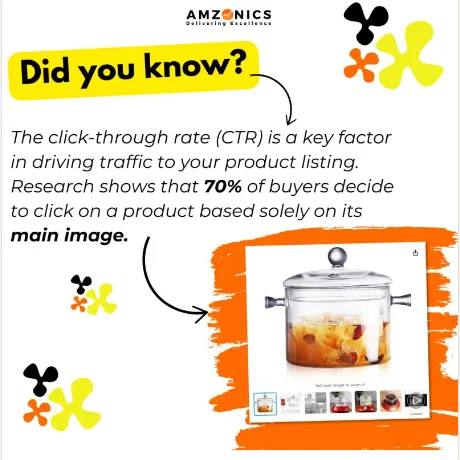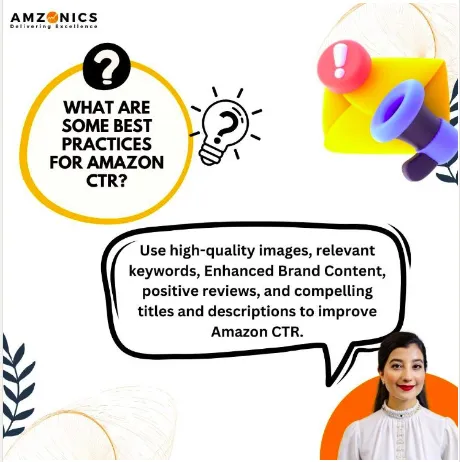Mastering Amazon CTR: Advanced Strategies, Myths, and Data-Driven Insights
Introduction: Why Amazon CTR is a Game Changer
Click-through rate (CTR) is the heartbeat of Amazon’s seller success. It’s not just a number; it’s a reflection of how compelling your listings are and how effectively you draw shoppers in. While sellers may focus on PPC and ranking, understanding the nuances of CTR can mean the difference between a profitable campaign and a wasted budget.
What is Amazon CTR?
Amazon CTR is the percentage of shoppers who click on your product after seeing it in search results or ads. For example, if your product is displayed 1,000 times and 100 people click, your CTR would be 10%. While that may seem simple, increasing CTR involves fine-tuning every aspect of your product listing.
Amazon CTR Benchmarks CTR varies depending on your product category and advertising type. Here’s a rough benchmark:
- Search Ads: 0.4% to 0.7%
- Sponsored Product Ads: 0.3% to 0.5%
- Display Ads: 0.2% to 0.3%
- Organic Listings: Can range between 1% to 5%

The Role of CTR in Amazon’s Algorithm
Amazon’s algorithm, A9, places a lot of weight on CTR because it indicates relevance and appeal. High CTR suggests that customers find your product compelling enough to click, which signals to Amazon that your product may be a good fit for other relevant searches.
The Impact of Product Images on CTR
The first product image is arguably the most critical factor in CTR. Amazon only shows the main image in search results, so it must be:
- High-resolution (minimum 1000x1000 pixels for zoomability)
- Clear and crisp, with no distracting backgrounds
- Focused on the product, ideally with a white background to meet Amazon’s image requirements
- A/B testing multiple images and tracking the CTR variations can help identify which image resonates best with your audience.

Optimizing Titles for Higher CTR
Your product title is another key driver of CTR. Keep it simple, packed with essential information, and SEO-optimized. Use keywords intelligently without stuffing them. A compelling title often has:
- The brand name.
- Key features (size, color, quantity).
- Keywords that fit naturally.
For instance, a poor title: “Water Bottle - 1L Blue” Optimized title: “Hydroflow 1L Insulated Stainless Steel Water Bottle - BPA Free, Keeps Drinks Cold for 24 Hours - Blue”
Bullet Points That Convert Clicks into Sales
Bullet points are crucial for turning clicks into conversions. But they also influence CTR by setting customer expectations. Use the bullet points to highlight value-driven features:
- Benefit-driven language
- Capitalized headers to grab attention
- Clear and concise sentences
For example, instead of saying "Lightweight," say, "Lightweight Design - Perfect for On-the-Go Hydration."
Understanding CTR in PPC Ads
CTR for Amazon PPC is particularly important since you pay for every click. Here's a breakdown:
- Sponsored Product Ads: These need eye-catching images and strong titles, as they appear within organic listings.
- Sponsored Brand Ads: Since these offer a headline and logo, they need a compelling narrative to engage shoppers.
- Sponsored Display Ads: These usually have the lowest CTR, but retargeting strategies can boost performance.
- A common mistake sellers make is not monitoring their PPC CTR. A low CTR might indicate poor targeting or unappealing creative elements.
How Pricing Influences CTR
Pricing is often overlooked, but shoppers on Amazon tend to compare prices quickly before clicking. Competitive pricing, especially during high-traffic events like Prime Day, is essential. Dynamic pricing strategies (adjusting prices based on competitors) can help maintain a high CTR. Myths Around Amazon CTR
Myth: High CTR Equals More Sales
While a high CTR suggests that your product listing is attracting clicks, it doesn’t always translate into conversions. Your product may not meet customer expectations once they land on the page, leading to a low conversion rate.
Myth: Only the First Image Matters
While the first image is the most critical, additional images play a huge role once the customer clicks. Use lifestyle images, infographics, and even videos to keep the shopper engaged and drive conversions.

Advanced Strategies for Boosting CTR
Use of Keywords in Sponsored Ads: Exact match keywords usually lead to better CTR since they align more closely with user intent. Phrase match and broad match keywords can dilute your targeting, but they may still be useful for generating data.
Creative Testing: Continuously test variations in product titles, images, and bullet points to see what works best. Amazon’s A/B testing (Manage Your Experiments) allows you to test various versions of your content.
Custom Audience Retargeting: Sponsored Display ads can be retargeted to audiences who previously viewed your product or similar products but didn’t convert. This targeted approach often results in a higher CTR.
Common Mistakes that Reduce CTR
- Ignoring Mobile Optimization: Over half of Amazon’s traffic comes from mobile. If your listings aren’t optimized for mobile devices, you’re leaving CTR on the table.
- Overlooking Reviews: Poor reviews or lack of reviews can tank your CTR. It’s essential to encourage buyers to leave positive reviews and address any negative feedback quickly.
- Not Utilizing Promotions: Coupons, discounts, and deals often show up in search results and can boost your CTR by making your product stand out.
- Analyzing Your CTR Data: What the Numbers Say
Data is your best friend when optimizing CTR. Tools like Helium 10 and Jungle Scout offer insights into click-through rates, traffic, and keyword performance. Keep track of:
- Search term report (for sponsored ads CTR)
- Organic CTR from keyword rankings
- Comparison of CTR between mobile and desktop users
While mastering Amazon CTR can seem complex, the rewards are well worth it. If you’re looking to take your Amazon CTR to the next level, a professional audit can pinpoint the exact areas that need improvement. The right tweaks can bring significant ROI. Let's talk about how we can help your business optimize CTR for better performance and higher profitability.
https://amzonics.com/
Conclusion: Boost Your Amazon CTR and Dominate the Market
CTR is not just another metric—it’s a key indicator of how well your product resonates with customers. By optimizing images, titles, bullet points, and pricing, you can significantly improve your CTR, resulting in more traffic and ultimately more sales. Regularly analyze your data, refine your strategies, and stay competitive in the ever-evolving Amazon marketplace.
